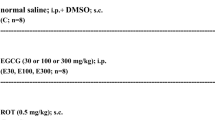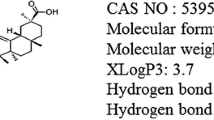Abstract
Rotenone (RO)-induced neurotoxicity exhibits pathophysiological features similar to those reported in patients with Parkinson’s disease (PD), such as nitrosative and oxidative stress, mitochondrial dysfunction, and neural cytoarchitecture alterations in the substantia nigra pars compacta (SNpc)/striatum (ST), which has been used for decades as an animal model of PD in humans. L-Theanine (LT), a major amino acid component of green tea, exhibits potent antioxidant and anti-inflammatory activities and protects against various neural injuries. We investigated the potential therapeutic effects of LT on RO-induced behavioral and neurochemical dysfunction in rats and the neuroprotective mechanisms underlying these effects. Unilateral stereotaxic intranigral infusion of RO into the SNpc to induce PD-like manifestations induced significant behavioral impairment as evaluated using an open field test, rotarod test, grip strength measurement, and beam-crossing task in rats. LT treatment (300 mg/kg i.p., 21 days) ameliorated most RO-induced behavioral impairments. In addition, LT treatment reduced nitric oxide level and lipid peroxidation production, increased mitochondrial function and integrity, as well as the activities of mitochondrial complexes I, II, IV, and V, and reduced the levels of neuroinflammatory and apoptotic markers in the SNpc and ameliorated the levels of catecholamines, GABA and glutamate in the ST induced by RO. These results demonstrate the possible therapeutic effects of LT against RO-induced behavioral impairments, including antioxidative effects, prevention of mitochondrial dysfunction, prevention of neurochemical deficiency, anti-neuroinflammatory effects, and anti-apoptotic effects. This is the first report on the neuroprotective effect of LT against RO-induced behavioral impairments, and the above evidence provides a potential clinically relevant role for LT in the management of human PD.








Similar content being viewed by others
Availability of Data and Material
The datasets used and/or analyzed in the current study are available from the corresponding author on reasonable request.
References
Aksoy D, Solmaz V, Çavuşoğlu T et al (2017) Neuroprotective effects of exenatide in a rotenone-induced rat model of Parkinson’s disease. Am J Med Sci 354:319–324
Anusha C, Sumathi T, Joseph LD (2017) Protective role of apigenin on rotenone induced rat model of Parkinson’s disease: Suppression of neuroinflammation and oxidative stress mediated apoptosis. Chem Biol Interact 269:67–79
Ball N, Teo WP, Chandra S, Chapman J (2019) Parkinson’s disease and the environment. Front Neurol 10:218
Beers RF Jr, Sizer IW (1952) A spectrophotometric method for measuring the breakdown of hydrogen peroxide by catalase. J Biol Chem 195:133–140
Chen CN, Chang KC, Wang MH et al (2018) Protective effect of L-theanine on haloperidol-induced orofacial. Chin J Physiol 61:35–41
Chen L, Huang Y, Yu X et al (2021) Corynoxine protects dopaminergic neurons through inducing autophagy and diminishing neuroinflammation in rotenone-induced animal models of Parkinson’s disease. Front Pharmacol 12:642900
Dickson DW (2018) Neuropathology of Parkinson disease. Parkinsonism Relat Disord 46(Suppl 1):S30–S33
Donzanti BA, Yamamoto BK (1988) An improved and rapid HPLC-EC method for the isocratic separation of amino acid neurotransmitters from brain tissue and microdialysis perfusates. Life Sci 43:913–922
Ellman GL (1959) Tissue sulfhydryl groups. Arch Biochem Biophys 82:70–77
Farombi EO, Awogbindin IO, Farombi TH et al (2019) Neuroprotective role of kolaviron in striatal redo-inflammation associated with rotenone model of Parkinson’s disease. Neurotoxicol 73:132–141
Fonnum F, Lock EA (2004) The contributions of excitotoxicity, glutathione depletion and DNA repair in chemically induced injury to neurones: exemplified with toxic effects on cerebellar granule cells. J Neurochem 88:513–531
Garabadu D, Agrawal N (2020) Naringin exhibits neuroprotection against rotenone-induced neurotoxicity in experimental rodents. NeuroMolecular Med 22:314–330
Green LC, Wagner DA, Glogowski J et al (1982) Analysis of nitrate, nitrite, and [15N]nitrate in biological fluids. Anal Biochem 126:131–138
Griffiths DE, Houghton RL (1974) Studies on energy-linked reactions: modified mitochondrial ATPase of oligomycin-resistant mutants of Saccharomyces cerevisiae. Eur J Biochem 46:157–167
Grünewald A, Kumar KR, Sue CM (2019) New insights into the complex role of mitochondria in Parkinson’s disease. Prog Neurobiol 177:73–93
Günaydın C, Avcı B, Bozkurt A et al (2019) Effects of agomelatine in rotenone-induced Parkinson’s disease in rats. Neurosci Lett 699:71–76
Hashem IAT, Yaqoob I, Anuar NB et al (2015) The rise of “big data” on cloud computing: review and open research issues. Inf Syst 47:98–115
Hashimoto M, Tanabe Y, Fujii Y et al (2005) Chronic administration of docosahexaenoic acid ameliorates the impairment of spatial cognition learning ability in amyloid beta-infused rats. J Nutr 135:549–555
Huang SG (2002) Development of a high throughput screening assay for mitochondrial membrane potential in living cells. J Biomol Screen 7:383–389
Jamwal S, Singh S, Gill JS, Kumar P (2017) L-theanine prevent quinolinic acid induced motor deficit and striatal neurotoxicity: Reduction in oxido-nitrosative stress and restoration of striatal neurotransmitters level. Eur J Pharmacol 811:171–179
Johnson ME, Bobrovskaya L (2015) An update on the rotenone models of Parkinson’s disease: their ability to reproduce the features of clinical disease and model gene-environment interactions. Neurotoxicol 46:101–116
Kamboj SS, Kumar V, Kamboj A, Sandhir R (2008) Mitochondrial oxidative stress and dysfunction in rat brain induced by carbofuran exposure. Cell Mol Neurobiol 28:961–969
Khadrawy YA, Salem AM, El-Shamy KA, Ahmed EK, Fadl NN, Hosny EN (2017) Neuroprotective and therapeutic effect of caffeine on the rat model of Parkinson’s disease induced by rotenone. J Diet Suppl 14:553–572
Konnova EA, Swanberg M (2018) Chapter 5 Animal models of Parkinson’s disease. In: Stoker TB, Greenland JC (eds) Parkinson’s disease: pathogenesis and clinical aspects [Internet]. Codon Publications, Brisbane
Korhonen R, Lahti A, Kankaanranta H, Moilanen E (2005) Nitric oxide production and signaling in inflammation. Curr Drug Targets Inflamm Allergy 4:471–479
Kouli A, Torsney KM, Kuan WL (2018) Chapter 1 Parkinson’s disease: etiology, neuropathology, and pathogenesis. In: Stoker TB, Greenland JC (eds) Parkinson’s disease: pathogenesis and clinical aspects [Internet]. Codon Publications, Brisbane
Kumar P, Kalonia H, Kumar A (2011) Novel protective mechanisms of antidepressants against 3-nitropropionic acid induced Huntington’s-like symptoms: a comparative study. J Psychopharmacol 25:1399–1411
Lowry OH, Rosebrough NJ, Farr AL, Randall RJ (1951) Protein measurement with the folin phenol reagent. J Biol Chem 193:265–275
Mancuso M, Coppede F, Migliore L et al (2006) Mitochondrial dysfunction, oxidative stress and neurodegeneration. J Alzheimers Dis 10:59–73
Mansour RM, Ahmed MAE, El-Sahar AE, El Sayed NS (2018) Montelukast attenuates rotenone-induced microglial activation/p38 MAPK expression in rats: possible role of its antioxidant, anti-inflammatory and antiapoptotic effects. Toxicol Appl Pharmacol 358:76–85
Misra HP, Fridovich I (1972) The role of superoxide anion in the autoxidation of epinephrine and a simple assay for superoxide dismutase. J Biol Chem 247:3170–3175
Ohkawa H, Ohishi N, Yagi K (1979) Assay for lipid peroxides in animal tissues by thiobarbituric acid reaction. Anal Biochem 95:351–358
Old SL, Johnson MA (1989) Methods of microphotometric assay of succinate dehydrogenase and cytochrome c oxidase activities for use on human skeletal muscle. Histochem J 21:545–555
Patel BA, Arundell M, Parker KH et al (2005) Simple and rapid determination of serotonin and catecholamines in biological tissue using high-performance liquid chromatography with electrochemical detection. J Chromatogr B 818:269–276
Paxinos G, Watson C (1998) The rat brain in stereotaxic coordinates. Academic Press, San Diego, p 4
Pedersen PL, Greenawalt JW, Reynafarje B et al (1978) Preparation and characterization of mitochondria and submitochondrial particles of rat liver-derived tissues. Methods Cell Biol 20:411–481
Perez-Lloret S, Barrantes FJ (2016) Deficits in cholinergic neurotransmission and their clinical correlates in Parkinson’s disease. NPJ Parkinsons Dis 2:16001
Saeed M, Khan MS, Kamboh AA et al (2020) L-theanine: an astounding sui generis amino acid in poultry nutrition. Poult Sci 99:5625–5636
Sanjari Moghaddam H, Zare-Shahabadi A, Rahmani F, Rezaei N (2017) Neurotransmission systems in Parkinson's disease. Rev Neurosci 28(5):509-536
Shapiro BL, Feigal RJ, Lam LF (1979) Mitochondrial NADH dehydrogenase in cystic fibrosis. Proc Natl Acad Sci U S A 76:2979–2983
Sharma S, Kumar P, Deshmukh R (2018) Neuroprotective potential of spermidine against rotenone induced Parkinson’s disease in rats. Neurochem Int 116:104–111
Soung HS, Wang MH, Chang KC et al (2018) L-theanine decreases orofacial dyskinesia induced by reserpine in rats. Neurotox Res 34:375–387
Storrie B, Madden EA (1990) Isolation of subcellular organelles. Methods Enzymol 182:203–225
Tapias V, McCoy JL, Greenamyre JT (2019) Phenothiazine normalizes the NADH/NAD+ ratio, maintains mitochondrial integrity and protects the nigrostriatal dopamine system in a chronic rotenone model of Parkinson’s disease. Redox Biol 24:101164
Tseng HC, Wang MH, Chang KC et al (2020) Protective effect of (-)epigallocatechin-3-gallate on rotenone-induced parkinsonism-like symptoms in rats. Neurotox Res 37:669–682
Türközü D, Şanlier N (2017) L-theanine, unique amino acid of tea, and its metabolism, health effects, and safety. Crit Rev Food Sci Nutr 57:1681–1687
Unno K, Muguruma Y, Inoue K et al (2020) Theanine, antistress amino acid in tea leaves, causes hippocampal metabolic changes and antidepressant effects in stress-loaded mice. Int J Mol Sci 22:193
Wang D, Gao Q, Wang T et al (2017) Theanine: The unique amino acid in the tea plant as an oral hepatoprotective agent. Asia Pac J Clin Nutr 26:384–391
Yang CC, Chang KC, Wang MH et al (2020) L-theanine improves functional recovery after traumatic spinal cord injury in rats. J Formos Med Assoc 119:1405–1414
Zaitone SA, Ahmed E, Elsherbiny NM et al (2019) Caffeic acid improves locomotor activity and lessens inflammatory burden in a mouse model of rotenone-induced nigral neurodegeneration: Relevance to Parkinson’s disease therapy. Pharmacol Rep 71:32–41
Funding
This study was supported by the Mackay Memorial Hospital (MMH-107–89) and Shin Kong Wu Ho-Su Memorial Hospital (2018SKHADR022).
Author information
Authors and Affiliations
Contributions
CNC collected the data, executed the majority of the experiments, and drafted the manuscript. MHW, HSS, SMC, CHF, and YWL contributed to the active discussion of experimental design and performing of the animal study. HCT supervised the study, assisted with study conceptualization, and made a substantial contribution to the revision of the manuscript. All authors have read and approved the final submitted manuscript.
Ethics declarations
Ethics Approval
All animal procedures and experiments were performed following a protocol approved by the National Taiwan University College of Medicine and Public Health Institutional Animal Care and Use Committee (IACUC no. 20180026).
Consent for Publication
Not applicable.
Conflict of Interest
The authors declare no competing interests.
Additional information
Publisher's Note
Springer Nature remains neutral with regard to jurisdictional claims in published maps and institutional affiliations.
Rights and permissions
About this article
Cite this article
Chen, CN., Wang, MH., Soung, HS. et al. L-Theanine Ameliorated Rotenone-Induced Parkinsonism-like Symptoms in Rats. Neurotox Res 40, 241–258 (2022). https://doi.org/10.1007/s12640-021-00451-w
Received:
Revised:
Accepted:
Published:
Issue Date:
DOI: https://doi.org/10.1007/s12640-021-00451-w




